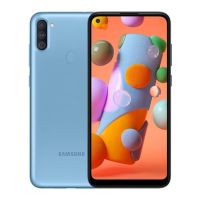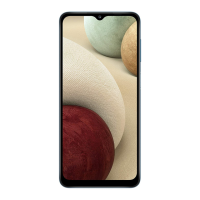Do you have a question about the Samsung SM-A155F/N and is the answer not in the manual?
Illustrates the physical components and their locations on the device.
Details the functions of the device's physical buttons like Side and Volume.
Explains the on-screen navigation buttons (Recents, Home, Back) and their functions.
Instructions for charging the device via wired and quick charging methods.
Tips and settings to conserve battery power, such as power saving mode.
Information and instructions for inserting a nano-SIM card.
Information and instructions for inserting a microSD card.
Basic procedures for powering the device on, off, or restarting.
How to force restart the device and make emergency calls.
Managing your Samsung account, including signing in and out.
Using Smart Switch to transfer data via USB or wirelessly.
Explains basic touch gestures like tapping, dragging, and swiping.
Details soft buttons, hiding the bar, and using swipe gestures.
Navigating between Home and Apps screens and editing the Home screen.
Changing screen lock methods, settings, and indicator icons.
Methods for capturing screenshots of the device's screen.
Managing notifications and accessing quick device controls.
Using the on-screen keyboard, changing languages, and additional functions.
How to copy and paste text within and between apps.
Guide to downloading, installing, and removing applications from the device.
Making calls, managing contacts, blocking numbers, and call options.
Sending, checking, sorting, deleting, and changing message settings.
Taking photos and videos, using modes like Portrait, Pro, and Night mode.
Viewing images and videos, organizing albums, and using the recycle bin.
Creating AR emojis, stickers, short videos, and contact profiles.
Running multiple apps simultaneously in split or pop-up view.
Browsing the web and using Secret Mode for private browsing.
Making payments, verifying identity, and using tickets with Samsung Wallet.
Managing wellness and fitness goals, tracking progress, and health tips.
Creating and saving notes using text, handwriting, or images.
Setting up a safe environment for children with parental controls.
Managing wearable devices and schedules with Calendar.
Setting reminders, completing, restoring, and deleting them.
Using the FM radio and recording voice memos.
Managing files, checking time, and performing calculations.
Organizing games and configuring the gaming environment.
Controlling smart devices and sharing content via Quick Share.
Sharing Bluetooth speaker audio with another person.
Mirroring the phone's screen content onto a TV or monitor.
Information on various Google apps like Chrome, Gmail, Maps, and YouTube.
Overview of customizing device settings and searching for specific settings.
Connecting to Wi-Fi networks and checking network quality.
Pairing Bluetooth devices and connecting via Wi-Fi Direct.
Using NFC for reading tags and making contactless payments.
Managing data usage and sharing the phone's connection.
Managing connections for Quick Share, Music Share, and other devices.
Creating and managing custom modes and automated routines.
Adjusting volume, ringtones, notification sounds, and vibration.
Managing notifications and customizing display options like brightness and dark mode.
Managing battery usage and customizing wallpaper and style.
Customizing themes, home screen layout, and lock screen options.
Managing unlock features and general security/privacy settings.
Setting up and using face recognition for unlocking the device.
Registering and using fingerprints for screen unlock and authentication.
Setting up, using, and uninstalling Secure Folder for private content.
Protecting Wi-Fi connections and apps with Secure Wi-Fi.
Registering, verifying, and using Samsung Pass for logins.
Managing location services and safety/emergency features.
Managing accounts, Samsung Cloud, Google Drive, and Smart Switch.
Enabling and configuring advanced device features like Labs and Side button.
Enabling and configuring motion-based features like lift-to-wake and palm swipe.
Installing and using a second instance of messenger apps.
Monitoring device usage and setting parental controls.
Improving device performance by closing apps, managing battery, and scanning for malware.
Customizing system settings like language, keyboard, and reset options.
Configuring settings to improve device accessibility for all users.
Updating software, checking security info, and accessing remote support.
Viewing device status, legal, software, and battery information.
General safety guidelines and precautions for using the device properly.
Explanation of warning, caution, and notice icons used in the manual.
Information about supplied items, accessories, and compatibility.
Identifying situations causing device heat-up during charging and use.
Steps to take if the device overheats and recommended operating temperature.
Avoiding conditions that can cause device overheating or damage.
Solutions for device errors, connectivity problems, and battery issues.
Troubleshooting touch screen response and device freezing problems.
Resolving call connectivity, network quality, and battery charging problems.
Resolving battery depletion, camera, and multimedia file error messages.
Resolving Bluetooth, computer connection, and location finding issues.
Troubleshooting data loss, storage, home button, and battery removal.
List of registered trademarks and copyrights for the device and software.
| Category | Cell Phone |
|---|---|
| Network Technology | GSM / HSPA / LTE |
| SIM | Single SIM (Nano-SIM) or Dual SIM (Nano-SIM, dual stand-by) |
| Main Camera Features | LED flash, panorama, HDR |
| Main Camera Video | 1080p@30fps |
| Selfie Camera Video | 1080p@30fps |
| Loudspeaker | Yes |
| 3.5mm jack | Yes |
| WLAN | Wi-Fi 802.11 a/b/g/n/ac, dual-band, Wi-Fi Direct |
| NFC | Yes (market/region dependent) |
| USB | USB Type-C 2.0 |
| Virtual Proximity Sensing | Yes |
| Battery Type | Li-Po 5000 mAh, non-removable |
| Model | SM-A155F/N |
| Status | Available |
| Build | Glass front, plastic frame, plastic back |
| Display Type | PLS LCD, 90Hz |
| Display Size | 6.5 inches |
| CPU | Octa-core |
| GPU | Mali-G52 |
| Internal Memory | 128GB 4GB RAM, 128GB 6GB RAM |
| Main Camera | 50 MP, f/1.8, (wide) |
| Bluetooth | 5.0, A2DP, LE |
| Positioning | GPS, GALILEO, GLONASS, BDS |
| Sensors | Accelerometer, gyro, compass |











